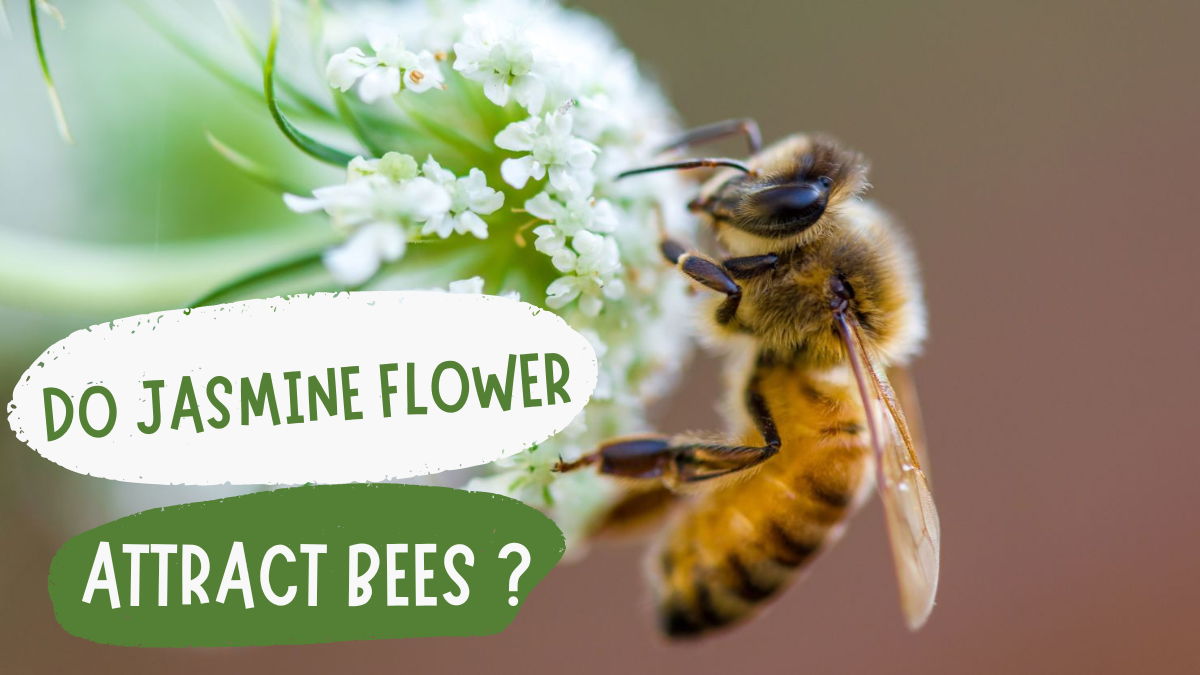Jasmine flower is used by many gardening enthusiasts and patio, yard, and garden designers for giving the space a mesmerizing look and filling it with its alluring fragrance; there’s no doubt why the jasmine flower is referred to as a gift from god. Jasmine flowers come in different shapes, sizes, and colors, like white, pink, and yellow. Among the different jasmine varieties, my favorite is the captivating night-blooming jasmine because it blooms at night. It does not attract pollinators like bees but will surely attract humans with its tremendous scent. So, in this article, I will answer this ticking question in your” mind: “Does Jasmine Flower Attract Bees? “
Does Jasmine Flower Attract Bees?
Does Star Jasmine Attract Bees?
Yes, jasmine flowers attract bees, but not all varieties of jasmine attract bees, like yellow jasmine, which is toxic to our tiny pollinating friend. Among all the jasmine varieties, bees are fascinated by the sweet and tempting fragrance of Confederate Jasmine, also known as Star Jasmine.
Jasmine Offcianale, commonly known as Summer Flowering Jasmine, also attracts different pollinators, including bees; some of you may see them as a threat, but you don’t have to fret. They are not here for you.
Bees have different points of view when looking at flowers. We adore the beauty and smell of the flower. They look at it as their food; they look at it as their food and feed on the flower’s nectar.
It’s a give-and-take business for both of them. In turn, bees also help plants reproduce, but that doesn’t. I don’t recommend using harmful pesticides to deter pests and insects from jasmine plants.
Bee Pollination Facts
- Nearby, 70 % of flowering plants, including jasmine, rely on pollinators.
- When a bee lands on a flower for nectar, it extracts pollen from it and transfers it from the male anthers to the female stigmata.
- Bees will greet those flowering plants in your garden loaded with nectar. Also, these tiny buzzing friends are in love with sweet-scented blooms.
- You will see more bees buzzing around the open flowers in the daytime.
- Bees require high energy for their long flights, and plants like jasmine provide them with sugar to fuel them up. The most common visitors to your garden are the bumblebees with yellow and black stripes and honeybees.
How Jasmine Flower Attracts Bees
Jasmine flowers are bee charmers; their mere existence in your garden will attract them in search of nectar; bees also leave traces of low ultraviolet reflectance at the middle of the flower, which helps other bees find the center of the flower. Yes, bees can see ultraviolet light.
Honey Bees get attracted from miles away by the sweet aroma of the jasmine blooms; bees spend most of their time searching for flowers to extract nectar & pollen. Most jasmine varieties bloom vivid yellow and shiny white flowers, a magnet for them. Jasmine flowers also provide them with a landing pad to unroll the flower.
Jasmine Flower Nectar
Like other flowers, jasmine blooms also produce nectar produced by a gland called nectaries; it is a viscous fluid enriched with sugar, which is later converted into honey. According to the Britannica, Nectar is considered the drink of gods. Jasmine nectar is also filled with carbohydrate-rich food, which in exchange they demand pollination services; sugar content in nectar differs from 15% to 75 %. Jasmine plants can also exploit bees by controlling the composition and concentration of nectar. Depending on how bees react while collecting nectar, plants reduce their production when their visits are not too frequent.
Floral nectaries can be located on the flower petals, stamens, sepals, and pistils, depending on the plant’s species. Jasmine floral nectaries are on the flower base ( stamens ).
Structure & Color
Plants have evolved their flowers by adapting the colors, scents, and shapes that can attract more pollinators. Does a jasmine flower attract bees based on its flower color and structure?
Yes, flowers are considered the reproductive part of flowering plants, and the vibrant yellow and white petals fascinate our buzzing friends for pollination. Some of the varieties of jasmine flowers have long stamens, which bees use as their landing pad and easily extract nectar and pollen from the blooms. The alluring petal structure flowers also spread their super scent, which can lure them from miles away.
Other Pollinators That Jasmine Attracts
The pretty creamy, yellow, and white colored jasmine flowers bloom in clusters and start offering you its flowers from spring till fall, which attracts bees and other pollinators like.
- Butterflies
- Hummingbirds
- Wasps
Conclusion
As we have seen, bees are interested in jasmine flowers because of their structure, shiny and attractive flowers, sweet, alluring scent, and how we can forget the nectar they provide to our buzzing companion. Bees and jasmine plants depend on each other; bees and other pollinators want sugar that gives them energy, and they help pollinate various plant species and crops. A report says honeybees alone hold up $ 15 billion worth of crops.
So, my lovely plant parents, start planting jasmine plants, and soon, they will bloom delightful aromatic flowers in your garden with a welcoming sign for gorgeous butterflies and other pollinators, adding a charming touch to your garden. It will also help build a great ecology or environment for our tiny buzzing companions.
What flower attracts the most bees?
Vibrant and aromatic flowers attract bees to your garden, yard, and patio. Here are some flowers that work as bee magnets.
Bee Balm, Purple Coneflower, Black Eyed Susan, Wild Indigo, Marsh Blazing Star.
Which flower gives the most honey?
It depends on the region and climate in which the flower plants thrive. Some flowers produce high amounts of nectar, which is later converted into honey.
Lavender, Alfalfa, Acacia.

1 thought on “Does Jasmine Flower Attract Bees ?”